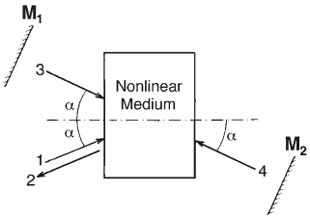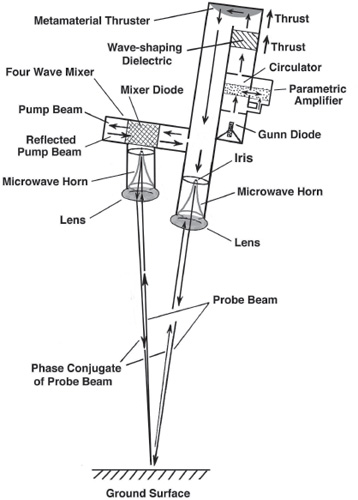Secrets of Antigravity Propulsion (31 page)

In most media, the electromagnetic wave interference pattern formed between the incoming probe beam and the pump beams would have no effect on light wave propagation, but in a polarized piezoelectric medium such as barium titanate, these field potentials are able to physically alter the index of refraction of the piezoelectric medium at a microscopic level.
Through this multifarious patterning of its index of refraction, the crystal is able to complexly scatter light waves passing through it so as to reconstruct the “time-reverse” phase conjugate beam.
If we were to think of the crystal as a computer hard drive, then the probe beam striking this crystal would, in effect, be writing data into this hard drive about all of the directions and phases of its various light rays.
This stored information refracts the pump beam, directing it to form an outgoing phase conjugate beam.
The pump beams entering the mixer need not be formed from a laser beam split off from the illuminating laser.
Rather, they may be spontaneously seeded from the probe beam, provided that mirrors are placed on either side of the mixer crystal at the proper angle.
How such a passive phase conjugate resonator works is summarized in the text box below.
The academic scientific community first became aware of optical phase conjugation through its members’ work with lasers.
Such laser experiments were conducted in 1972 at the Lebedev Physical Institute in Moscow.
Subsequently, scientists in the United States and other countries began investigating the phenomenon.
1,
2
This technology found a military application in the development of a Star Wars weapon that can track an enemy missile target by illuminating it with a beam of laser light and subsequently destroy the target by sending out a powerful laser pulse that converges onto the target, retracing the path of the light rays that had reflected from the target.
In 1994, when I first heard about Project Skyvault, the only reference to phase conjugation was in experiments that were being conducted at optical wavelengths with lasers, but Don’s discourse on microwave beam mixing immediately led me to conclude that Project Skyvault was performing microwave beam phase conjugation.
I conducted a literature search, but it turned up no references to the use of phase conjugation at microwave frequencies.
Nevertheless, I concluded that if phase conjugation worked at optical wavelengths, it should work just as well at microwave wavelengths.
Since that time, a significant amount of research on microwave phase conjugation has been published, indicating that my earlier conclusion was indeed justified.

Figure 8.3.
A self-pumped optical phase conjugate mirror showing an incoming probe beam (1) interacting with counterpropagating pump beams (3 and 4) between mirrors M1 and M2 to produce the outgoing phase conjugate beam (2).
Optical Phase Conjugate Resonance in Barium Titanate
When a probe laser beam, or “seed” beam of coherent laser light (see ray 1, figure 8.3), is directed to pass into a nonlinear dielectric medium, such as an electrically polarized crystal of barium titanate, and this dielectric is placed between two parallel mirrors, this probe beam will excite two counterpropagating “pump beams” (see rays 3 and 4, figure 8.3) to build up between the mirrors.
These pump beams interact with the incoming probe beam to produce a stationary periodic electric field and refractive index pattern termed a
holographic amplitude grating
.
Experiments have shown that the counterpropagating pump beams can self-excite to intensities sixty times that of the input signal beam without any additional energy input.
3,
4
Higher amplification coefficients could be achieved by reducing the losses of the resonator cavity and by taking advantage of natural resonances in the nonlinear dielectric.
This passive resonator also functions as a phase conjugate mirror.
The holographic amplitude grating produced by the interaction of the pump beam (ray 3 in figure 8.3) with the incoming probe beam (ray 1) refracts the counterpropagating pump beam (ray 4) to yield an outgoing time-reversed beam (ray 2), also called a phase conjugate beam.
Similarly, the grating produced by the interaction of the beams (rays 4 and 1) refracts the counterpropagating pump beam (ray 3) to produce a similar outgoing phase conjugate beam (ray 2) in phase with that produced by the other pump beam (ray 4).
The electromagnetic wave fronts in the outgoing beam (ray 2) are identical to the ordinary wave fronts in the probe beam (ray 1), except that they propagate backward instead of forward, precisely retracing the paths followed by the forward-moving wave fronts of the ordinary beam.
Consequently, the barium titanate crystal functions as a self-pumped optical phase conjugate mirror.
If the probe beam were to originate from a certain point, this phase conjugate mirror would reflect a beam that converges back to that point.
This principle is used in Star Wars weapons designed to track and destroy missiles by using a laser beam.
However, if microwave phase conjugation was indeed being used in Project Skyvault, we get a very different picture of the historical development of this branch of science.
It indicates that about two decades before academia discovered phase conjugation in laser experiments, this phenomenon was under intense investigation by aerospace black-project scientists studying its ability to amplify and bottle up microwave radiation into intense downward-directed beams from aircraft.
If made to function as a microwave phase conjugate resonator, a radar unit could be able to automatically lock on to and track its target and also to exponentially amplify the intensity of the incoming radar echo.
Instead of being dispersed into the environment, most of the radar signal’s energy would become confined to a nondispersing beam extending between the radar unit and the target.
This has the advantage of allowing very intense microwave beams to be built up with very little input power, clearly an advantage if one needed to generate intense microwave beams for vehicle propulsion.
Thus, Don’s rather cryptic description of the Skyvault vehicle propulsion unit makes quite a bit of sense if he was describing a microwave device that operates similar to a phase conjugate resonator.
With some knowledge of how a phase conjugate resonator functions, we can understand Don’s description of the Micro-X unit as follows.
The Skyvault vehicle has a high-voltage DC power source on board that drives a high-power Gunn diode mounted within a resonator conduit mounted below the craft.
Coherent microwave radiation emitted from the Gunn diode repeatedly reflects back and forth along the length of this conduit and becomes amplified in voltage.
Dielectrics placed in the conduit transform the signal into a sawtooth-shaped waveform.
The microwave radiation from this resonator passes through an iris and radiates downward through a microwave horn.
A convex lens focuses the radiation into a beam that shines on the ground (see figure 8.4).
A fraction of this radiation is absorbed in the ground and the remaining fraction is scattered upward, of which a small portion scatters back toward the craft.
A second convex microwave lens mounted below the spacecraft intercepts a portion of this scattered radiation, which constitutes the incoming probe beam, and focuses it through another iris into another resonator cavity that contains the mixer diode.
The mixer diode is essentially a block of material such as barium titanate or some other substance that has nonlinear electric properties and is electrically polarized with high-voltage DC.
Since microwave wavelengths are about a thousand times larger than visible wavelengths, the mixer medium need not be a transparent or translucent crystal; an amorphous barium titanate ceramic works just as well.
Furthermore, a portion of the microwave radiation in the Gunn diode resonator cavity is diverted into the mixer diode cavity, where it enters the mixer diode.
This pump beam passes through the mixer diode and reflects from the far end of the resonator cavity.
The cavity is designed to have a length that is a whole-number multiple of the Gunn diode wavelength to ensure that resonance is achieved.
This establishes two counterpropagating phase-locked pump beams within the cavity.
The mixer diode’s electric polarization axis is oriented at the proper angle relative to these pump beams.

Figure 8.4.
A rendition of the phase conjugate microwave resonator propulsion unit used in Project Skyvault.
(P.
LaViolette, © 2006)
Within the mixer diode medium, the probe beam interacts with each of the two counterpropagating pump beams to produce a holographic electrostatic grating pattern.
In turn, the grating pattern produced by a given pump beam interacts with the opposing pump beam to produce an outgoing microwave beam that is the phase conjugate of the probe microwave beam, or, in other words, is the phase conjugate of the radiation scattered back to the craft from the ground target site.
As was the case with laser light phase conjugation, the waveform, angle, and phase of the phase conjugate microwave beam are configured just like those of the incoming probe beam, except that the waves propagate in a reverse direction.
As such, these phase conjugate rays exactly retrace the paths followed by the ground-reflected rays and ultimately converge back to the probe beam’s point of origin.
That is, this time-reversed beam converges on the ground-reflection site and then continues to retrace the probe beam’s path, ultimately entering the spacecraft’s Gunn diode oscillator cavity.
This arrangement of two counterpropagating pump beams, an incoming probe beam, and outgoing phase conjugate beam, all interacting within the craft’s nonlinear mixer diode, constitutes a four-wave mixer.
Since the oscillation phases of the probe and phase conjugate beams are precisely matched, these ordinary and time-reversed waves reinforce one another to produce a resonantly amplified stationary wave pattern, or soliton, between the craft’s mixer resonator cavity and the ground and between the ground and the craft’s Gunn diode resonator cavity.
As a result, the electromagnetic energy beamed to the ground from the Gunn diode amplifier cavity and also the energy beamed back to the ground as the outgoing phase conjugate beam become efficiently stored in this soliton beam.
Based on the large body of knowledge that has been accumulated about the phase conjugation phenomenon, we know this energy storage soliton phenomenon to be fact.
This stationary wave in effect behaves as a giant energy capacitor.
The soliton’s intensity progressively builds up to a very high value, limited only by absorption energy losses when the microwave beam contacts surfaces that partially absorb the microwave radiation.
The soliton beam develops specifically between high-reflectivity ground scattering surfaces.
Ground scattering sites illuminated by the beam that are very absorbing to microwave radiation will return little radiation to the mixer, and hence, those ray paths will carry an insignificantly small fraction of the soliton beam’s total energy flux.
Considering that passive phase conjugate resonators using barium titanate crystals have developed sixtyfold power gains over their seed (probe) laser beam intensity, we might speculate that Project Skyvault was able to achieve microwave beam intensity gains of at least two orders of magnitude and perhaps higher.
If they used a Gunn diode that operated at a power of 10 kilowatts, then the soliton beam could have stored 1 to 10 megawatts of energy.
If, on the other hand, the craft used a parametric amplifier to amplify the Gunn diode beam to a power of several million watts, then the soliton beam could have stored several gigawatts.